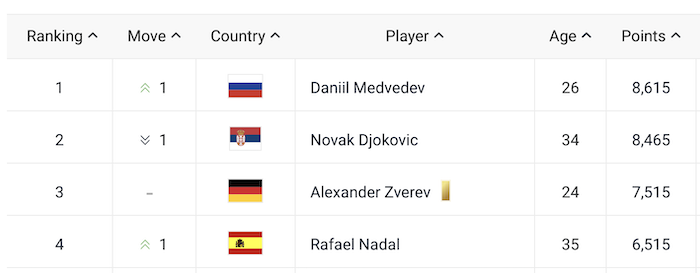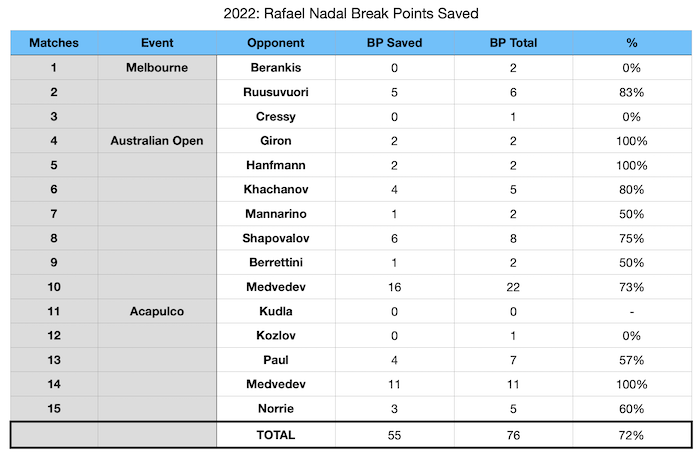Rafael’s 2022 Renaissance.
The 35-year-old Spaniard has:
- won his first 15 matches in a row to start 2022. That’s the best start to a season ever for the Spaniard.
- won 13 sets in a row.
- won the last 11 finals in a row he has competed in.
- moved up one spot in the ATP Rankings this week to No. 4 in the world.
Here are the latest rankings.
ATP Rankings – February 28, 2022

So, what exactly is powering the resurgence? Is it coming more from the serving side, or returning side, or something more specific? Let’s dig into his 15 matches in 2022 and compare them to his Career Hard Court Average to see where the improvement is coming from.
Break Points Saved
- 2022 = 72%
- Career Hard Ct Average = 66%
- Difference = +6 percentage points
Nothing is moving the needle more in 2022 vs. his hard court average than Break Points Saved. There is a six percentage point difference between the two, which is the greatest of any match metric.
Specifically fueling this is Rafa’s two matches against Daniil Medvedev, where he saved 73% (16/22) in the Australian Open final and 100% (11/11) in their Acapulco semi-final. Combined against Medvedev, he has saved a whopping 82% (27/33). Those are crazy numbers and definitely paint an accurate picture of why Nadal is 15-0 so far this season.
Nadal has played three matches where he saved all the break points he faced and also faced zero break points in his first match in Acapulco against Denis Kudla.

Facing break points is going to happen in our sport – even if you are Rafael Nadal having the best start to a season in your career. Keep in mind that he has lost 21 break points in 15 matches.
Getting broken is going to happen! But he is really locking in under pressure.
He is bending but not breaking.
Service Games Won
- 2022 = 90%
- Career Hard Ct Average = 86%
- Difference = +4 percentage points
Saving more break points will obviously have a direct positive effect on holding serve more often. Rafa is four percentage points higher than his tour average in this metric. As a point of reference, he holds serve 85% of the time on clay. He must feel like Superman going through a stretch holding nine times out of 10 on hard.
Return Games Won
- 2022 = 33%
- Career Hard Ct Average = 29%
- Difference = +4 percentage points
So we know he is loving life on the serving side of the equation. He is also posting above-average numbers with Return Games Won as well. Rafa is also plus four percentage points with Return Games won. It’s interesting that Service Games Won and Return Games Won have both increased by the same percentage point margin.
1st Serves Won
- 2022 = 76%
- Career Hard Ct Average = 73%
- Difference = +3 percentage points
When the first serve goes in, Rafa is winning three percentage points more in 2022 than his career hard court average. I imagine this rise is due to a combination of better serve placement, more return errors, and more Serve +1 forehands to immediately cause havoc with.
1st Serve Returns Won
- 2022 = 34%
- Career Hard Ct Average = 32%
- Difference = +2 percentage points
This area has notched up two percentage points. Remarkably, Rafa has won 40 per cent or more in five of his 15 matches.
- vs. Kozlov = 52% (17/33)
- vs. Giron = 47% (23/49)
- vs. Paul = 45% (21/47)
- vs. Berankis = 44% (17/39)
- vs. Norrie = 40% (16/40)
The match where he performed the worst was against Berrettini, winning just 26% (18/68).
Return Points Won
- 2022 = 42%
- Career Hard Ct Average = 40%
- Difference = +2 percentage points
This area has also ticked up two percentage points. In two matches, Nadal actually won more points returning than his opponent did serving. Those were against Kozlov (55%) and Paul (54%).
2nd Serve Returns Won
- 2022 = 56%
- Career Hard Ct Average = 54%
- Difference = +2 percentage points
What’s amazing about this stat is that Rafa has won more than 50% of 2nd serve return points in 12 of 15 of his matches. He completely owns his opponent’s second serve. Rafa was particularly in devastating form in Acapulco, facing 2nd serves.
Acapulco ATP500 – 2nd Serve Return Points Won
- Match 1 vs. Kudla = 67% (14/21)
- Match 2 vs. Kozlov = 63% (5/8)
- Match 3 vs. Paul = 72% (21/29)
- Match 4 vs. Medvedev = 75% (18/24)
- Match 5 vs. Norrie = 53% (10/19)
- TOTAL = 67% (68/101)
Rafa especially dismantled his opponent’s second serves in Acapulco.
Break Points Converted
- 2022 = 43%
- Career Hard Ct Average = 42%
- Difference = +1 percentage point
Rafa has a +6 percentage point increase in saving break points but only a one percentage point improvement in converting break points compared to his career hard court average. This area is doing fine, but not crushing it like when he saves break points while serving.
Service Points Won
- 2022 = 69%
- Career Hard Ct Average = 68%
- Difference = +1 percentage point
A slight uptick here as well with service points won.
Total Points Won
- 2022 = 55%
- Career Hard Ct Average = 54%
- Difference = +1 percentage point
This is a metric that is very, very hard to move the needle – even one percentage point. When players win 55% of all points they play, then they are basically undefeated. They rule the universe, which is Rafa so far in 2022.
1st Serves Made
- 2022 = 66%
- Career Hard Ct Average = 67%
- Difference = -1 percentage point
I would have naturally thought that he is getting more first serves in than normal. The numbers are very close, but he is actually getting slightly less in (66%) compared to his career hardcourt average (67%).
2nd Serves Won
- 2022 = 55%
- Career Hard Ct Average = 57%
- Difference = -2 percentage points
Interesting that this has dropped a little, down to 55% from 57%. Eight of his matches were above 50%, but five of his matches were below 50% won. Those were Norrie (42%), Bernakis (43%), Shapovalov (46%), Paul (46%), and Medvedev (47%).
Summary
Rafa is 15-0 primarily because he is handling the pressure of saving break points at a rarified level.
Opponents have got him to break point 76 times in 15 matches. They have only converted 21 of those points, which is simply not going to get the job done. Rafa is winning almost three out of four (72%) of these “kingmaker” points. When it all boils down to it, this is specifically driving his unbeaten start to the season.
Can’t beat him if you can’t break him.

